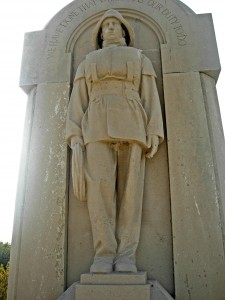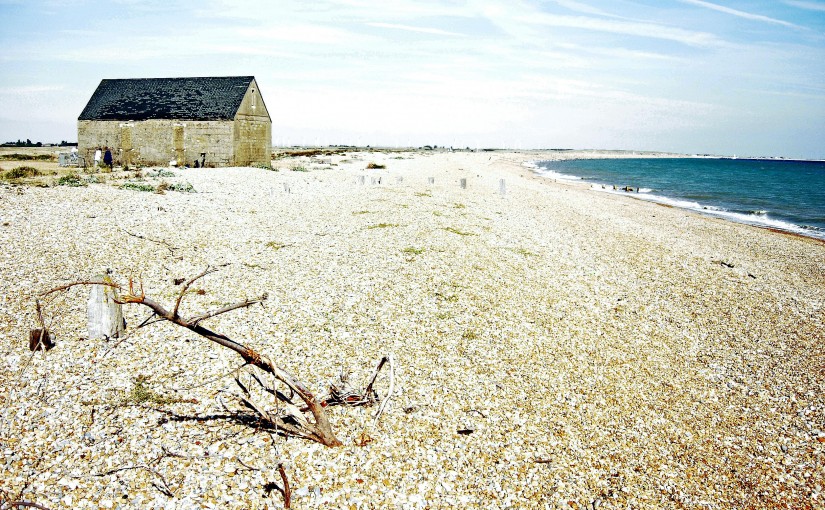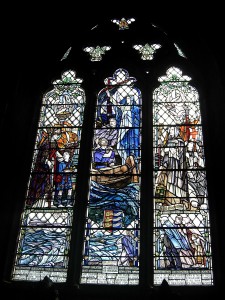Seventeen men battled with backs bent against the furious force of the wind along the straight stretch of beach to the Mary Stanford Lifeboat House between Rye Harbour and Winchelsea Beach. It was pitch black at 5 am on 15 November 1928 when the maroon went up, and the lifeboat crew members left the comfort of their beds to rush to the boathouse a mile and a half away. The crew was not alone, but was supported by a team of launchers who all played their part in getting the boat to sea.
Gales of up to 80 miles an hour and huge seas in the English Channel caused the Latvian ship, Alice of Riga, to collide with the larger German steamer, the Smyrna. The Alice, now rudderless, began shipping water through a gash in her side, so the Smyrna’s captain alerted North Foreland Radio Station with a simple message – “Steamer Alice Riga leaking – danger – drifting SW to W 8 miles from Dungeness 0430”.
The tide was low and launching difficult at the boathouse, and so the Mary Stanford – this pulling and sailing, non self-righting Liverpool class lifeboat weighing over four tons – had to be dragged 1000 yards along the shore before she got off on the third attempt at 6.44 am, carrying 17 already fatigued men.
They put to sea never having seen the recall signal that would have let them know that the launch was no longer necessary. The Smyrna had, in fact, already rescued the crew of the Alice. 17 good men and true lost their lives when the Mary Stanford capsized only a mile and a half from shore.

15 November this year marks the 80th anniversary of that cruel irony, which will be remembered by family descendents, RNLI and other boat crews, and members of the public at a commemorative service at Rye Harbour church on Sunday, 16 November. The small churchyard became the repository of the village’s grief and loss as coffin after coffin was placed in the single grave on 20 November 1928. A stark reminder of that dreadful day graces the churchyard in the form of a white memorial, a sou’westered lifeboatman looking pensively down at the names of the fathers and sons who selflessly gave their lives.
I recently attended an exhibition in Winchelsea entitled “The Social History of Winchelsea in Photos 1850 – 2008”. There, amongst the dozens of fascinating photos, was the Mary Stanford, rightfully taking her place. The pictures reminded me that Winchelsea was also involved in the story of the lifeboat, and I walked across to the church of St. Thomas the Martyr to be reacquainted with the beautiful coloured window in the south wall.
The Lifeboat Memorial Window was the gift of Lord Blanesburgh, of Greyfriars, Winchelsea, one of the Lords of Appeal. After the Mary Stanford disaster he had commissioned Douglas Stachan, LLD, Hon RSA and stained glass artist, to create the window. In fact, Stachan’s daughter, Una, in a brief biographical booklet about her father, remembers that her family had just been holidaying in the area and had visited St. Thomas’ church. None of the windows contained stained glass and Una remarked to her father, “Daddy, look at all these lovely empty windows for you to fill”.
The window was later unveiled on 6 July 1929. Christ the Bestower of Peace is at the centre, calming the storm, St. Augustine is on the right, and appropriately St. Nicholas, patron saint of seamen, is on the left.
Beautiful though these are, it is the smaller panels across the bottom that tell the real story. In the centre the Mary Stanford can be seen struggling against mountainous waves towards the damaged ship (left), whilst families watch and wait (right). The poignancy of the disaster is captured at a glance.
I stopped to read the inscription underneath the window and found myself marvelling at the ability of Sir Henry Newbolt to encapsulate both memory and sentiment into this fitting epitaph. With a lump in my throat, I read, “These men of Rye Harbour, crew of the Lifeboat Mary Stanford, having confirmed the habit of a noble service the courage handed down by their fathers, were quick to hear the cry of humanity above the roaring sea. In the darkness of their supreme hour, they stayed not to weigh doubt or danger but freely offering their portion of this life for the ransom of men they had never known, they went boldly into the last of all storms. Their names are here recorded in acknowledgement that we have received in trust for England the memory of their faithfulness and loving kindness”.
This was powerful stuff, and knowing nothing about Henry Newbolt, I went home and looked him up. He was a barrister, an authority on naval matters, and a poet, who lived from 1862 to 1938. Coincidentally some of his poems were set to music by a man named Stanford.
I have recently joined a dynamic and enterprising group called “Friends of the Mary Stanford Lifeboat House”, whose aim is to restore the Mary Stanford lifeboat house in order to create a “coastal classroom” for children who visit Rye Harbour Nature Reserve. The group is working with English Heritage, the Environment Agency and RNLI Rye Harbour to secure the future of the building , and need to raise £200,000.
If you would like to become a Friend, please download your membership form from www.ryeharbourlifeboathouse.co.uk If you are not on line, but would like to contribute, please send your name, address and donation to the Project Co-ordinator, who, in an unbelievable coincidence, is called Jacqueline Mary Stanford. She lives at Dabchick Cottage, Morlais Place, Winchelsea Beach, TN36 4LG. Since Jacqui is no relation, the Friends are regarding her involvement as a “meant to be”.
The Friends are holding their own event to mark the 80th anniversary of the Mary Stanford tragedy. Geoff Hutchinson will give his striking presentation on the disaster at St. Thomas The Martyr Church, Winchelsea, on Friday 15 November at 7 pm. Tickets cost £10 and are available by phoning Jacqui on 01797 226908, or popping into the Post Office and Little Shop, Winchelsea, or visiting Windmill Orchards Farm Shop. Please come and support the Friends at this very appropriate and educational event. Geoff’s performance brings the story alive.
In closing, let us remember the men who, in the words on the Rye Harbour churchyard memorial, “…. have done that which was our duty to do”. Lest we forget, they were Herbert Head; Joseph Stonham; Henry Cutting; Albert Cutting; Robert Cutting; Walter Igglesden; Charles Southerden; James Head; John Head; Charles Pope; Alex Pope; Robert Pope; Morriss Downey; Arthur Downey; Leslie Clark; and William Clark, the entire crew of the Mary Stanford lifeboat, lost at sea 15 November 1928.

